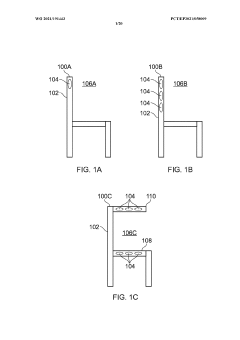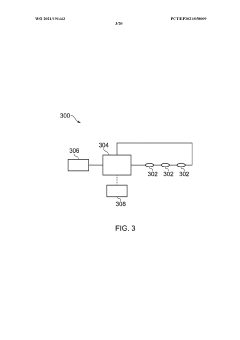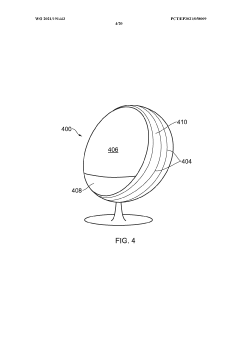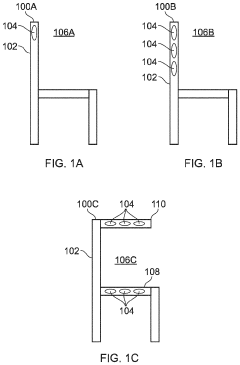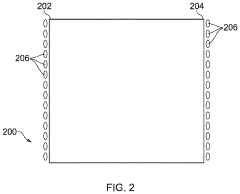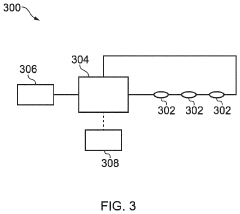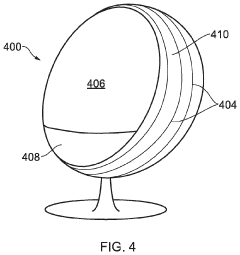Schumann Resonance and its Influence on Human Health
JUN 24, 20259 MIN READ
Generate Your Research Report Instantly with AI Agent
Patsnap Eureka helps you evaluate technical feasibility & market potential.
Schumann Resonance Background and Research Objectives
Schumann resonance, discovered by physicist Winfried Otto Schumann in 1952, refers to the natural electromagnetic frequencies occurring in the Earth's ionosphere cavity. These resonances, primarily at 7.83 Hz and its harmonics, have been a subject of increasing scientific interest due to their potential influence on human health and well-being.
The Earth's ionosphere and surface form a natural cavity that resonates with electromagnetic waves, creating a constant background frequency. This phenomenon is driven by global lightning activity, which excites the Earth-ionosphere cavity and generates these standing waves. The fundamental frequency of 7.83 Hz, often called the Earth's "heartbeat" or "natural tuning fork," has remained relatively stable since its discovery.
Research on Schumann resonance has evolved significantly over the past decades, expanding from purely geophysical studies to investigations of its potential biological and health effects. This shift in focus is rooted in the observation that the fundamental Schumann frequency closely aligns with human brain wave patterns, particularly those associated with relaxation, creativity, and overall well-being.
The primary objective of current research in this field is to elucidate the mechanisms by which Schumann resonance may influence human physiology and cognitive function. Scientists aim to understand whether exposure to these natural electromagnetic fields plays a role in regulating circadian rhythms, affecting sleep patterns, or modulating various physiological processes.
Another key research goal is to investigate the potential therapeutic applications of Schumann resonance. Some studies suggest that artificial recreation of these frequencies might have beneficial effects on human health, potentially aiding in stress reduction, improving sleep quality, and enhancing overall well-being. However, these claims require rigorous scientific validation.
Furthermore, researchers are exploring the possible implications of changes in the Earth's electromagnetic environment on human health. As human activities and technological advancements continue to alter the planet's electromagnetic landscape, understanding the role of natural electromagnetic fields becomes increasingly crucial.
The technological objectives of Schumann resonance research include developing more sensitive and accurate measurement techniques to detect and analyze these low-frequency signals. This involves creating advanced sensors and signal processing algorithms capable of isolating Schumann resonances from other electromagnetic noise sources.
In conclusion, the study of Schumann resonance and its potential impact on human health represents a fascinating intersection of geophysics, biology, and medicine. As research in this field progresses, it promises to shed light on the intricate relationship between the Earth's natural electromagnetic environment and human physiology, potentially opening new avenues for health and wellness applications.
The Earth's ionosphere and surface form a natural cavity that resonates with electromagnetic waves, creating a constant background frequency. This phenomenon is driven by global lightning activity, which excites the Earth-ionosphere cavity and generates these standing waves. The fundamental frequency of 7.83 Hz, often called the Earth's "heartbeat" or "natural tuning fork," has remained relatively stable since its discovery.
Research on Schumann resonance has evolved significantly over the past decades, expanding from purely geophysical studies to investigations of its potential biological and health effects. This shift in focus is rooted in the observation that the fundamental Schumann frequency closely aligns with human brain wave patterns, particularly those associated with relaxation, creativity, and overall well-being.
The primary objective of current research in this field is to elucidate the mechanisms by which Schumann resonance may influence human physiology and cognitive function. Scientists aim to understand whether exposure to these natural electromagnetic fields plays a role in regulating circadian rhythms, affecting sleep patterns, or modulating various physiological processes.
Another key research goal is to investigate the potential therapeutic applications of Schumann resonance. Some studies suggest that artificial recreation of these frequencies might have beneficial effects on human health, potentially aiding in stress reduction, improving sleep quality, and enhancing overall well-being. However, these claims require rigorous scientific validation.
Furthermore, researchers are exploring the possible implications of changes in the Earth's electromagnetic environment on human health. As human activities and technological advancements continue to alter the planet's electromagnetic landscape, understanding the role of natural electromagnetic fields becomes increasingly crucial.
The technological objectives of Schumann resonance research include developing more sensitive and accurate measurement techniques to detect and analyze these low-frequency signals. This involves creating advanced sensors and signal processing algorithms capable of isolating Schumann resonances from other electromagnetic noise sources.
In conclusion, the study of Schumann resonance and its potential impact on human health represents a fascinating intersection of geophysics, biology, and medicine. As research in this field progresses, it promises to shed light on the intricate relationship between the Earth's natural electromagnetic environment and human physiology, potentially opening new avenues for health and wellness applications.
Market Analysis for Schumann Resonance Applications
The market for Schumann Resonance applications is experiencing significant growth, driven by increasing awareness of its potential health benefits and technological advancements in measurement and application. The global market for electromagnetic therapy devices, which includes Schumann Resonance-based products, is projected to reach substantial value in the coming years. This growth is fueled by rising consumer interest in alternative and complementary health solutions, particularly in developed countries.
The primary market segments for Schumann Resonance applications include personal wellness devices, professional health equipment, and environmental monitoring systems. Personal wellness devices, such as Schumann Resonance generators and wearables, are gaining popularity among health-conscious consumers seeking to improve sleep quality, reduce stress, and enhance overall well-being. These products are often marketed as natural solutions for combating the negative effects of electromagnetic pollution in urban environments.
In the professional health sector, Schumann Resonance-based therapies are being integrated into holistic health practices, wellness centers, and some alternative medicine clinics. This segment is driven by practitioners looking for non-invasive treatment options for stress-related disorders, sleep disturbances, and general health optimization. The market is also seeing increased interest from research institutions and hospitals exploring the potential medical applications of Schumann Resonance.
Environmental monitoring systems utilizing Schumann Resonance measurements are finding applications in geophysical research, climate studies, and potentially in early warning systems for natural disasters. This niche market segment is primarily driven by scientific and governmental organizations.
Geographically, North America and Europe are leading the market due to higher consumer awareness and spending on wellness products. However, the Asia-Pacific region is expected to show the fastest growth rate in the coming years, attributed to increasing disposable incomes, growing health consciousness, and the traditional acceptance of energy-based therapies in countries like China and India.
Key market trends include the integration of Schumann Resonance technology with smart home systems, the development of more sophisticated and user-friendly personal devices, and increasing research collaborations between technology companies and health institutions to validate the efficacy of Schumann Resonance applications.
Challenges in the market include the need for more robust scientific evidence supporting health claims, regulatory hurdles in some regions, and consumer education on the concept and benefits of Schumann Resonance. Despite these challenges, the market shows promising growth potential, driven by the increasing global focus on preventive healthcare and natural wellness solutions.
The primary market segments for Schumann Resonance applications include personal wellness devices, professional health equipment, and environmental monitoring systems. Personal wellness devices, such as Schumann Resonance generators and wearables, are gaining popularity among health-conscious consumers seeking to improve sleep quality, reduce stress, and enhance overall well-being. These products are often marketed as natural solutions for combating the negative effects of electromagnetic pollution in urban environments.
In the professional health sector, Schumann Resonance-based therapies are being integrated into holistic health practices, wellness centers, and some alternative medicine clinics. This segment is driven by practitioners looking for non-invasive treatment options for stress-related disorders, sleep disturbances, and general health optimization. The market is also seeing increased interest from research institutions and hospitals exploring the potential medical applications of Schumann Resonance.
Environmental monitoring systems utilizing Schumann Resonance measurements are finding applications in geophysical research, climate studies, and potentially in early warning systems for natural disasters. This niche market segment is primarily driven by scientific and governmental organizations.
Geographically, North America and Europe are leading the market due to higher consumer awareness and spending on wellness products. However, the Asia-Pacific region is expected to show the fastest growth rate in the coming years, attributed to increasing disposable incomes, growing health consciousness, and the traditional acceptance of energy-based therapies in countries like China and India.
Key market trends include the integration of Schumann Resonance technology with smart home systems, the development of more sophisticated and user-friendly personal devices, and increasing research collaborations between technology companies and health institutions to validate the efficacy of Schumann Resonance applications.
Challenges in the market include the need for more robust scientific evidence supporting health claims, regulatory hurdles in some regions, and consumer education on the concept and benefits of Schumann Resonance. Despite these challenges, the market shows promising growth potential, driven by the increasing global focus on preventive healthcare and natural wellness solutions.
Current State and Challenges in Schumann Resonance Research
Schumann Resonance research has made significant strides in recent years, with advancements in measurement techniques and data analysis. Current studies focus on understanding the complex interactions between the Earth's electromagnetic field and various atmospheric phenomena. Researchers have developed more sensitive instruments capable of detecting subtle changes in the resonance frequencies, allowing for more accurate measurements and analysis.
One of the primary challenges in Schumann Resonance research is the isolation of the signal from background noise. The extremely low frequency of these resonances makes them susceptible to interference from both natural and artificial sources. Scientists are continually working on improving signal processing algorithms and filtering techniques to enhance the quality of collected data.
The global nature of Schumann Resonances presents another challenge, as it requires coordinated efforts from multiple observation stations worldwide. Establishing and maintaining a network of synchronized monitoring stations is crucial for comprehensive data collection and analysis. This global approach is essential for understanding the spatial and temporal variations of the resonances.
Recent studies have explored the potential links between Schumann Resonances and various aspects of human health and well-being. While some research suggests correlations between resonance fluctuations and certain physiological and psychological parameters, establishing definitive causal relationships remains a significant challenge. The complexity of human biology and the subtle nature of these electromagnetic interactions make it difficult to isolate and quantify their effects.
Another area of ongoing research is the investigation of how human activities, particularly the increasing use of electromagnetic technologies, might influence or interfere with natural Schumann Resonances. Understanding these potential interactions is crucial for assessing any long-term impacts on the Earth's electromagnetic environment.
The interdisciplinary nature of Schumann Resonance research presents both opportunities and challenges. Collaboration between geophysicists, atmospheric scientists, biologists, and medical researchers is essential for a comprehensive understanding of the phenomenon and its potential implications. However, integrating diverse scientific perspectives and methodologies can be challenging.
Advancements in computational power and machine learning techniques are opening new avenues for analyzing the vast amounts of data generated by Schumann Resonance monitoring. These tools offer the potential for identifying subtle patterns and correlations that may not be apparent through traditional analysis methods. However, developing and validating these new analytical approaches remains an ongoing challenge in the field.
One of the primary challenges in Schumann Resonance research is the isolation of the signal from background noise. The extremely low frequency of these resonances makes them susceptible to interference from both natural and artificial sources. Scientists are continually working on improving signal processing algorithms and filtering techniques to enhance the quality of collected data.
The global nature of Schumann Resonances presents another challenge, as it requires coordinated efforts from multiple observation stations worldwide. Establishing and maintaining a network of synchronized monitoring stations is crucial for comprehensive data collection and analysis. This global approach is essential for understanding the spatial and temporal variations of the resonances.
Recent studies have explored the potential links between Schumann Resonances and various aspects of human health and well-being. While some research suggests correlations between resonance fluctuations and certain physiological and psychological parameters, establishing definitive causal relationships remains a significant challenge. The complexity of human biology and the subtle nature of these electromagnetic interactions make it difficult to isolate and quantify their effects.
Another area of ongoing research is the investigation of how human activities, particularly the increasing use of electromagnetic technologies, might influence or interfere with natural Schumann Resonances. Understanding these potential interactions is crucial for assessing any long-term impacts on the Earth's electromagnetic environment.
The interdisciplinary nature of Schumann Resonance research presents both opportunities and challenges. Collaboration between geophysicists, atmospheric scientists, biologists, and medical researchers is essential for a comprehensive understanding of the phenomenon and its potential implications. However, integrating diverse scientific perspectives and methodologies can be challenging.
Advancements in computational power and machine learning techniques are opening new avenues for analyzing the vast amounts of data generated by Schumann Resonance monitoring. These tools offer the potential for identifying subtle patterns and correlations that may not be apparent through traditional analysis methods. However, developing and validating these new analytical approaches remains an ongoing challenge in the field.
Existing Methods for Measuring Schumann Resonance
01 Devices for generating Schumann resonance frequencies
Various devices have been developed to generate Schumann resonance frequencies for potential health benefits. These devices aim to simulate the natural electromagnetic frequencies of the Earth, which are believed to have positive effects on human health and well-being. The devices may include wearable technology, room-based generators, or portable units that emit specific frequencies associated with Schumann resonances.- Devices for generating Schumann resonance frequencies: Various devices have been developed to generate Schumann resonance frequencies for potential health benefits. These devices aim to simulate the natural electromagnetic frequencies of the Earth, which are believed to have positive effects on human health and well-being. The devices may include electromagnetic field generators, sound systems, or specialized chambers designed to create an environment rich in Schumann resonances.
- Therapeutic applications of Schumann resonance: Research suggests that exposure to Schumann resonance frequencies may have therapeutic applications for human health. These applications include stress reduction, improved sleep quality, enhanced cognitive function, and potential benefits for various physiological processes. Therapeutic devices and methods incorporating Schumann resonance aim to harness these potential health benefits.
- Wearable devices incorporating Schumann resonance technology: Wearable devices have been developed to provide individuals with continuous exposure to Schumann resonance frequencies. These devices may take the form of bracelets, pendants, or other accessories that generate or transmit Schumann resonance frequencies. The goal is to offer portable and convenient access to the potential health benefits associated with these frequencies.
- Integration of Schumann resonance in living spaces: Efforts have been made to incorporate Schumann resonance technology into living spaces, such as homes and offices. This may involve the use of specialized lighting systems, wall-mounted devices, or room-scale generators that create an environment rich in Schumann resonance frequencies. The aim is to provide continuous exposure to these frequencies in everyday living environments for potential health benefits.
- Measurement and analysis of Schumann resonance for health monitoring: Systems and methods have been developed for measuring and analyzing Schumann resonance frequencies in relation to human health. These technologies may involve sensors and data analysis tools to monitor an individual's exposure to Schumann resonances and correlate this information with various health parameters. Such systems could potentially be used for health monitoring and personalized wellness recommendations.
02 Therapeutic applications of Schumann resonance
Research suggests that exposure to Schumann resonance frequencies may have therapeutic applications for human health. These applications include stress reduction, improved sleep quality, enhanced cognitive function, and potential benefits for various health conditions. Studies have explored the use of Schumann resonance in complementary and alternative medicine practices.Expand Specific Solutions03 Schumann resonance monitoring and measurement
Devices and methods have been developed for monitoring and measuring Schumann resonance frequencies in the environment. These tools allow researchers and health practitioners to study the relationship between natural electromagnetic fields and human health. Advanced sensors and data analysis techniques are employed to detect and analyze Schumann resonance patterns.Expand Specific Solutions04 Integration of Schumann resonance in wellness products
Various wellness products have been designed to incorporate Schumann resonance technology. These may include specialized bedding, furniture, or personal care items that aim to expose users to beneficial frequencies. The integration of Schumann resonance into everyday objects is intended to provide continuous exposure to potentially health-promoting electromagnetic fields.Expand Specific Solutions05 Schumann resonance in electromagnetic shielding
Research has explored the use of Schumann resonance principles in developing electromagnetic shielding technologies. These innovations aim to protect human health from potentially harmful electromagnetic fields while maintaining exposure to beneficial frequencies associated with Schumann resonances. Such technologies may be applied in living spaces, workplaces, or personal protective equipment.Expand Specific Solutions
Key Players in Schumann Resonance Research
The research on Schumann Resonance and its influence on human health is in an emerging stage, with growing interest from both academic institutions and medical technology companies. The market size is expanding as more potential applications in healthcare and wellness are explored. Technologically, it's still in early development, with varying levels of maturity across different players. Academic institutions like the University of Bern, Max Planck Society, and Icahn School of Medicine at Mount Sinai are leading fundamental research. Meanwhile, companies such as Medtronic, Koninklijke Philips, and Neuroenhancement Lab are exploring practical applications, potentially integrating Schumann Resonance into medical devices and wellness products. The field is characterized by a mix of established medical technology firms and specialized research entities, indicating a competitive landscape that's still taking shape.
Medtronic, Inc.
Technical Solution: Medtronic has developed a novel approach to studying Schumann Resonance (SR) and its potential health effects. Their research focuses on creating medical devices that can detect and potentially harness SR for therapeutic purposes. They have designed a series of sensors capable of measuring extremely low-frequency electromagnetic fields associated with SR. These sensors are integrated into wearable devices that can monitor an individual's exposure to SR in real-time. Additionally, Medtronic is exploring the possibility of using SR-mimicking frequencies in their neurostimulation devices to potentially enhance their effectiveness in treating various neurological disorders.
Strengths: Extensive experience in medical device development, strong research capabilities, and potential for integrating SR into existing product lines. Weaknesses: Limited published research specifically on SR, potential regulatory hurdles for new SR-based therapies.
Koninklijke Philips NV
Technical Solution: Philips has been investigating the potential influence of Schumann Resonance on human health through their sleep and respiratory care division. They have developed a prototype sleep environment system that incorporates SR-mimicking electromagnetic fields. This system uses advanced sensors to detect local electromagnetic disturbances and generates a compensating field to maintain a stable SR-like environment. Philips is also exploring the integration of SR concepts into their air purification systems, hypothesizing that maintaining a natural electromagnetic environment indoors could have positive effects on overall well-being. Their research includes long-term studies on sleep quality and respiratory health in environments with controlled SR-like fields.
Strengths: Strong presence in consumer health technology, extensive experience in sleep and respiratory care. Weaknesses: Early stage of SR-specific research, potential challenges in proving definitive health benefits.
Core Studies on Schumann Resonance and Human Health
A magnetic field exposure system and uses thereof
PatentWO2021191443A1
Innovation
- A magnetic field exposure system generating an amplitude-modulated low frequency magnetic field with a carrier frequency of 360 to 450 Hz and a modulation frequency of 0.5 to 100 Hz, with a field strength of 0.5 to 250 mT, specifically designed to expose organic cells or tissues to improve cell survival, proliferation, reduce stress, and enhance well-being.
A magnetic field exposure system and uses thereof
PatentPendingUS20230372726A1
Innovation
- A magnetic field exposure system generating an amplitude-modulated low frequency magnetic field with a carrier frequency of 360 to 450 Hz and a modulation frequency of 0.5 to 100 Hz, providing a field strength of 0.5 to 250 μT, specifically designed to enhance cell survival, proliferation, reduce stress, and promote tissue regeneration.
Regulatory Framework for Electromagnetic Health Studies
The regulatory framework for electromagnetic health studies related to Schumann Resonance (SR) and its influence on human health is a complex and evolving landscape. Various international organizations and national bodies have established guidelines and standards to address the potential health effects of electromagnetic fields (EMFs), including those in the extremely low frequency (ELF) range where SR falls.
The World Health Organization (WHO) plays a crucial role in coordinating international efforts to assess the health risks of EMF exposure. Through its International EMF Project, the WHO provides a framework for harmonizing EMF standards worldwide. This project aims to establish a scientific basis for assessing health risks and developing protective measures against EMF exposure.
The International Commission on Non-Ionizing Radiation Protection (ICNIRP) is another key player in setting guidelines for EMF exposure. Their recommendations are widely adopted by many countries and serve as a basis for national regulations. The ICNIRP guidelines cover a wide range of frequencies, including the ELF range relevant to SR studies.
At the national level, regulatory bodies such as the Federal Communications Commission (FCC) in the United States and the European Commission in the European Union have established their own EMF exposure limits. These regulations often incorporate or reference international guidelines while adapting them to local contexts and specific needs.
Research on SR and its potential health effects falls under the broader category of bioelectromagnetics studies. Regulatory frameworks for such research typically require adherence to ethical guidelines, including obtaining informed consent from study participants and ensuring the safety of experimental protocols. Institutional Review Boards (IRBs) or Ethics Committees play a crucial role in overseeing and approving research designs involving human subjects.
Funding for SR and human health research often comes from a mix of government agencies, academic institutions, and private organizations. Regulatory bodies may influence research priorities through targeted funding initiatives and by setting research agendas that address specific health concerns related to EMF exposure.
As the field of SR research and its potential health implications continues to evolve, regulatory frameworks are likely to adapt. This may involve updating exposure limits, refining research protocols, and developing new guidelines for emerging technologies that interact with or influence the SR phenomenon. Ongoing collaboration between researchers, policymakers, and regulatory bodies will be essential to ensure that the regulatory framework remains responsive to new scientific findings and public health concerns.
The World Health Organization (WHO) plays a crucial role in coordinating international efforts to assess the health risks of EMF exposure. Through its International EMF Project, the WHO provides a framework for harmonizing EMF standards worldwide. This project aims to establish a scientific basis for assessing health risks and developing protective measures against EMF exposure.
The International Commission on Non-Ionizing Radiation Protection (ICNIRP) is another key player in setting guidelines for EMF exposure. Their recommendations are widely adopted by many countries and serve as a basis for national regulations. The ICNIRP guidelines cover a wide range of frequencies, including the ELF range relevant to SR studies.
At the national level, regulatory bodies such as the Federal Communications Commission (FCC) in the United States and the European Commission in the European Union have established their own EMF exposure limits. These regulations often incorporate or reference international guidelines while adapting them to local contexts and specific needs.
Research on SR and its potential health effects falls under the broader category of bioelectromagnetics studies. Regulatory frameworks for such research typically require adherence to ethical guidelines, including obtaining informed consent from study participants and ensuring the safety of experimental protocols. Institutional Review Boards (IRBs) or Ethics Committees play a crucial role in overseeing and approving research designs involving human subjects.
Funding for SR and human health research often comes from a mix of government agencies, academic institutions, and private organizations. Regulatory bodies may influence research priorities through targeted funding initiatives and by setting research agendas that address specific health concerns related to EMF exposure.
As the field of SR research and its potential health implications continues to evolve, regulatory frameworks are likely to adapt. This may involve updating exposure limits, refining research protocols, and developing new guidelines for emerging technologies that interact with or influence the SR phenomenon. Ongoing collaboration between researchers, policymakers, and regulatory bodies will be essential to ensure that the regulatory framework remains responsive to new scientific findings and public health concerns.
Ethical Considerations in Schumann Resonance Research
The ethical considerations in Schumann Resonance research are multifaceted and require careful attention from researchers, policymakers, and healthcare professionals. One primary concern is the potential misuse or misinterpretation of research findings, which could lead to unsubstantiated health claims or pseudoscientific practices. It is crucial to maintain scientific integrity and ensure that all research is conducted with rigorous methodologies and peer-reviewed before dissemination to the public.
Privacy and data protection issues also arise when conducting studies on the influence of Schumann Resonance on human health. Researchers must adhere to strict protocols to safeguard participants' personal information and health data. Informed consent procedures should be comprehensive, clearly explaining the nature of the research, potential risks, and the use of collected data.
The equitable distribution of potential benefits from Schumann Resonance research is another ethical consideration. If significant health benefits are discovered, there is a responsibility to ensure that any resulting treatments or interventions are accessible to all populations, regardless of socioeconomic status or geographical location.
Environmental impact is an important ethical aspect to consider. As research may involve the use of equipment that generates or measures electromagnetic fields, care must be taken to minimize any potential disruption to natural ecosystems or wildlife that may be sensitive to these fields.
There are also concerns about the potential for electromagnetic hypersensitivity (EHS) and the nocebo effect. Researchers must be cautious in their communications to avoid creating undue anxiety or psychosomatic symptoms in individuals who may be particularly susceptible to such concerns.
The ethical implications of long-term exposure studies on human subjects must be carefully weighed. While such studies may provide valuable insights, the potential risks to participants' health must be thoroughly assessed and mitigated. Ethical review boards play a crucial role in evaluating the risk-benefit ratio of proposed research protocols.
Interdisciplinary collaboration is essential to address the complex ethical issues surrounding Schumann Resonance research. Bioethicists, medical professionals, environmental scientists, and social scientists should be involved in shaping research agendas and interpreting results to ensure a holistic approach to ethical considerations.
Lastly, transparency in reporting both positive and negative results is paramount. Researchers have an ethical obligation to publish all findings, regardless of whether they support or refute the hypothesized effects of Schumann Resonance on human health. This commitment to transparency helps prevent publication bias and ensures that the scientific community and the public have access to a complete picture of the research landscape.
Privacy and data protection issues also arise when conducting studies on the influence of Schumann Resonance on human health. Researchers must adhere to strict protocols to safeguard participants' personal information and health data. Informed consent procedures should be comprehensive, clearly explaining the nature of the research, potential risks, and the use of collected data.
The equitable distribution of potential benefits from Schumann Resonance research is another ethical consideration. If significant health benefits are discovered, there is a responsibility to ensure that any resulting treatments or interventions are accessible to all populations, regardless of socioeconomic status or geographical location.
Environmental impact is an important ethical aspect to consider. As research may involve the use of equipment that generates or measures electromagnetic fields, care must be taken to minimize any potential disruption to natural ecosystems or wildlife that may be sensitive to these fields.
There are also concerns about the potential for electromagnetic hypersensitivity (EHS) and the nocebo effect. Researchers must be cautious in their communications to avoid creating undue anxiety or psychosomatic symptoms in individuals who may be particularly susceptible to such concerns.
The ethical implications of long-term exposure studies on human subjects must be carefully weighed. While such studies may provide valuable insights, the potential risks to participants' health must be thoroughly assessed and mitigated. Ethical review boards play a crucial role in evaluating the risk-benefit ratio of proposed research protocols.
Interdisciplinary collaboration is essential to address the complex ethical issues surrounding Schumann Resonance research. Bioethicists, medical professionals, environmental scientists, and social scientists should be involved in shaping research agendas and interpreting results to ensure a holistic approach to ethical considerations.
Lastly, transparency in reporting both positive and negative results is paramount. Researchers have an ethical obligation to publish all findings, regardless of whether they support or refute the hypothesized effects of Schumann Resonance on human health. This commitment to transparency helps prevent publication bias and ensures that the scientific community and the public have access to a complete picture of the research landscape.
Unlock deeper insights with Patsnap Eureka Quick Research — get a full tech report to explore trends and direct your research. Try now!
Generate Your Research Report Instantly with AI Agent
Supercharge your innovation with Patsnap Eureka AI Agent Platform!
